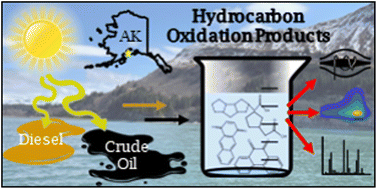Photochemical formation of water-soluble oxyPAHs, naphthenic acids, and other hydrocarbon oxidation products from Cook Inlet, Alaska crude oil and diesel in simulated seawater spills†
Abstract
Hydrocarbon oxidation products (HOPs) formed from crude oil and diesel were formed from laboratory simulated spills at four different periods (1, 4, 7, and 10 days) under environmental conditions that mimicked those in Cook Inlet, Alaska. Two sets of analyses were performed to identify and characterize the HOPs. The first set of analyses performed was non-targeted and included high-resolution mass spectrometry and fluorescence excitation-emission matrix spectroscopy. Liquid chromatography coupled with an Orbitrap mass spectrometer uncovered that HOPs formed from Cook Inlet (CI) crude oil and diesel are relatively reduced, saturated, and unsaturated compounds. The molecular compositions of HOPs from crude oil are more aromatic, whereas those formed from diesel are more aliphatic. Moreover, molecular signatures of naphthenic acids, a class of toxicants, in HOPs are reported. Six unique chemical features of HOPs were revealed by fluorescence excitation-emission matrix spectroscopy, including two unique petroleum signatures. The parallel factor model for fluorescence excitation-emission matrix spectroscopy accurately tracks temporal compositional changes of HOPs. The second set of analyses was targeted and included the quantification of polycyclic aromatic hydrocarbons (PAHs) and oxygenated polycyclic aromatic hydrocarbons (oxyPAHs) in HOPs using tandem mass spectrometry. Two oxyPAHs, phenanthrenequinone, and 1,4-anthraquinone were quantified in HOPs formed from CI crude oil and related to eleven PAHs. The results from this study uncover a comprehensive approach to monitoring compositional changes of hydrocarbon oxidation products in a spill event.

- This article is part of the themed collection: Outstanding Papers 2023 – Environmental Science: Advances


 Please wait while we load your content...
Please wait while we load your content...